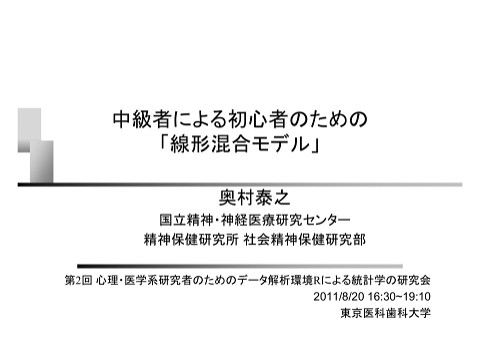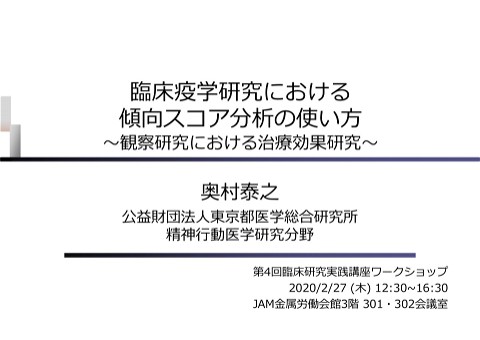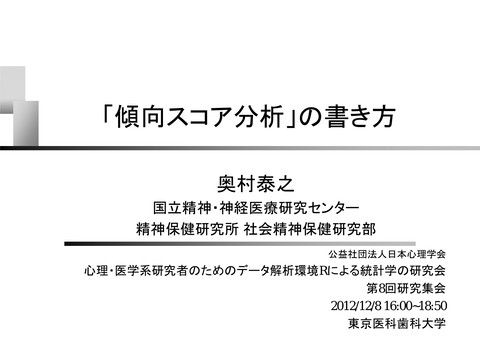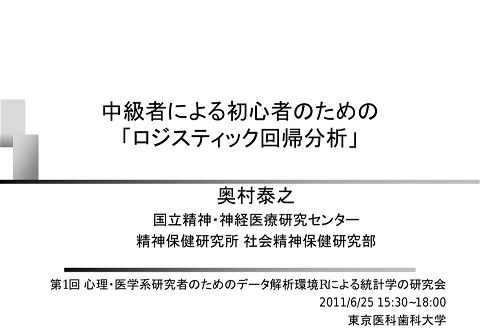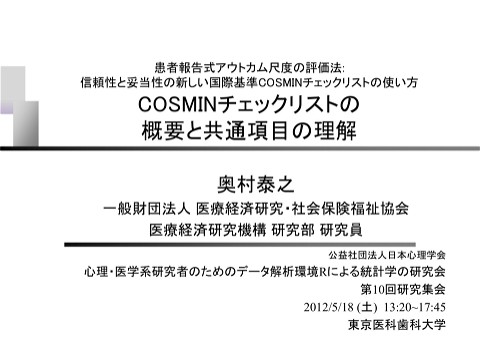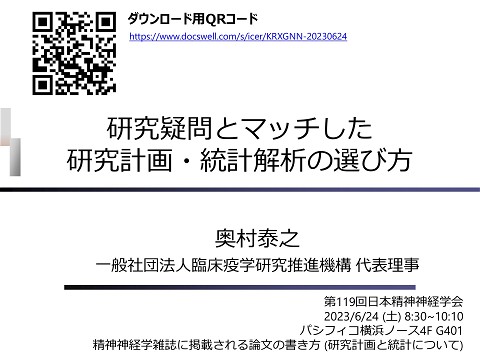中級者による初心者のための「探索的因子分析」
63.8K Views
May 24, 22
スライド概要
関連スライド
各ページのテキスト
中級者による初心者のための 「探索的因子分析」 奥村泰之 国立精神・神経医療研究センター 国立精神 神経医療研究センタ 精神保健研究所 社会精神保健研究部 公益社団法人日本心理学会 心理・医学系研究者のためのデータ解析環境Rによる統計学の研究会 第4回研究集会 究 2012/1/14 16:30~18:55 東京医科歯科大学
話題 探索的因子分析 (EFA) の特徴 (7 min) Reporting Guidelineと適正報告調査 (2 min) 項目詳細 (25 min) 落ち葉拾い (10 min) Rによる探索的因子分析 (EFA) (0 min) i ) 中級者向けの推薦文献 (1 min) 2
探索的因子分析 (EFA) の特徴 英語表記 • Exploratory/Explanatory Factor Analysis (EFA) 統計モデル 構造方程式モデル • 潜在変数 (独立変数) は量的変数 • 観測変数 (従属変数) は量的変数 潜在変数 観測変数 量的 質的 量的 質的 因子分析 潜在プロフィル分析 項目反応理論 潜在クラス分析 3
探索的因子分析 (EFA) の特徴 使用目的 観測変数間の相関を説明する潜在変数を同定 表 6科目のテストの相関行列 表. 科目 テ 相関行列 変数 1 2 3 4 5 6 1. ゲ ゲール語 ル語 ― 2. 英語 .439 ― 3. 歴史 .410 .351 ― 4. 計算 .288 .354 .164 ― 5. 代数 .329 .320 .190 .595 ― 6. 幾何 .248 .329 .181 .470 .464 ― N = 220 4
探索的因子分析 (EFA) の特徴 使用目的 観測変数間の相関を説明する潜在変数を同定 • 1因子モデル – 一般知能が高い→各テストの得点が高い 一般知能 ゲー ル語 英語 歴史 計算 代数 幾何 e1 e2 e3 e4 e5 e6 5
探索的因子分析 (EFA) の特徴 使用目的 観測変数間の相関を説明する潜在変数を同定 • 2因子モデル – 文化的能力が高い→語学関連のテストの得点が高い – 数学的能力が高い→数学関連のテストの得点が高い – 文化的能力と数学的能力には関連がある 文化的能力 数学的能力 ゲー ル語 英語 歴史 計算 代数 幾何 e1 e2 e3 e4 e5 e6 6
探索的因子分析 (EFA) の特徴 事例①新しい尺度の開発 目的 • オピオイド鎮痛薬治療の阻害要因の測定法を開発 研究法 • がん以外のオピオイド鎮痛薬治療患者1,114名に がん以外のオピオイド鎮痛薬治療患者1 114名に 電話調査 測定法 • 15項目 (3 or 5段階評定) の面接法を作成 – 問題因子: e.g., 治療により日常生活への関心を失う – 関心因子: e.g., 友人や家族は,私がオピオイド鎮痛薬 に依存していると思っている Banta-Green et al: Clin J Pain 26:489–497, 2010 7
探索的因子分析 (EFA) の特徴 事例②既存の尺度の評価 目的 • 筋骨格系疾患患者における,うつ病の尺度 (Hospital Anxiety and Depression Scale: HADS) の潜在変数を同定 潜在変数を同定 – HADS = 14項目,4段階評定の質問紙 調査対象 • 疼痛外来における296名の筋骨格系疾患患者 結果 • 先行研究と同様に2因子 (不安と抑うつ) を支持 項目 機能 除 • 一項目の機能が悪いので削除 Pallant et al: Health Qual Life Outcomes 3:82, 2005 8
話題 探索的因子分析 (EFA) の特徴 (7 min) Reporting Guidelineと適正報告調査 (2 min) 項目詳細 (25 min) 落ち葉拾い (10 min) Rによる探索的因子分析 (EFA) (0 min) i ) 中級者向けの推薦文献 (1 min) 9
Reporting Guidelineと適正報告調査 Reporting Guideline 特徴 • EFAの適正報告に関する基準をn個作成 • 基準の詳細な説明 論文 (赤字は推薦文献) • Schmitt TA: Current methodological considerations in exploratory and confirmatory factor analysis (J Psychoeduc Assess 29: 304-321, 2011) • Bandalos et al: Factor analysis: exploratory and confirmatory (The reviewer’s guide to quantitative methods in the social sciences: 93-114 93 114, 2010) • Matsunaga M: How to factor-analyze your data right: Do's, don'ts, and how- to's. International Journal of Psychological research (Int J Psychol Res 3: 97-110, 2010) • Preacher et al: Repairing p g Tom Swift's electric factor analysis y machine ((Underst Stat 2: 13-43, 2003) • Reise et al: Factor analysis and scale revision (Psychol Assess 12: 287-297, 2000) • Floyd y et al: Factor analysis y in the development p and refinement of clinical assessment instruments (Psychol Assess 7: 286-299, 1995) 10
Reporting Guidelineと適正報告調査 適正報告調査 特徴 • EFAの適正報告に関する基準をn個作成 • EFAを使用した論文を系統的に検索・収集 EFAを使用した論文を系統的に検索 収集 • 作成した基準を満たしているか評定 論文(赤字は推薦文献) • Norris et al: Evaluating the use of exploratory factor analysis in developmental disabilityy p psychological y g research ((J Autism Dev Disord 40: 8-20, 2010)) • Henson et al: Use of exploratory factor analysis in published research: Common errors and some comment on improved practice (Educ Psychol Meas 66: 393-416, 2006) • Worthington et al: Scale development research: A content analysis and recommendations for best practices (Couns Psychol 34: 806-838, 2006) • Costello et al: Best practices in exploratory factor analysis: Four recommendations for getting the most from your analysis. analysis (Practical Assess Res Eval 10, 10 2005) 11
Reporting Guidelineと適正報告調査 適正報告調査 論文(赤字は推薦文献) • Henson et al: Reporting practices and use of exploratory factor analyses in educational research journals: Errors and explanation (Res Sch 11: 61-72, 2004) • Conway et al: A review and evaluation of exploratory factor analysis practices in organizational research (Organ Res Methods 6: 147-168, 2003) • Fabrigar et al: Evaluating the use of exploratory factor analysis in psychological research ((Psychol y Methods 4: 272-299,, 1999)) • Hetzel RD: A primer on factor analysis with comments on patterns of practice and reporting (Adv Soc Sci Methodol 4: 175-206, 1996) • Ford et al: The application pp of exploratory p y factor analysis y in applied pp p psychology y gy : A critical review and analysis. Personnel Psychology (Pers Psychol 39: 291-314, 1986) 12
Reporting Guidelineと適正報告調査 HensonのGuideline • (1) EFAかCFAの選択 • (2)-① 相関行列/分散共分散行列 • (2)-② ② 母数推定法 • (2)-③ 分析結果の再現可能性 • (3) 因子数決定法 • (4) 回転法 • (5) 因子負荷量 • (6)-① ( ) ① 共通性 • (6)-② 因子寄与率 • (7) 因子の命名 Henson et al: Educ Psychol Meas 66: 393-416, 2006 13
話題 探索的因子分析 (EFA) の特徴 (7 min) Reporting Guidelineと適正報告調査 (2 min) 項目詳細 (25 min) 落ち葉拾い (10 min) Rによる探索的因子分析 (EFA) (0 min) i ) 中級者向けの推薦文献 (1 min) 14
項目詳細 (1) EFAかCFAの選択 推奨 • 事前に理論が存在するときは,確認的因子分析 (Confirmatory Factor Analysis: CFA) をEFAの代用として考 を 代用とし 考 慮すること 15
項目詳細 (1) EFAかCFAの選択 EFAとCFAの相違 • EFA = 仮説生成 • CFA = 仮説検証 文化的能力 数学的能力 文化的能力 数学的能力 ゲー ル語 英語 歴史 計算 代数 幾何 ゲー ル語 英語 歴史 計算 代数 幾何 e1 e2 e3 e4 e5 e6 e1 e2 e3 e4 e5 e6 16
項目詳細 (1) EFAかCFAの選択 EFAを選択すべき状況 • 新しい尺度の開発[1] • 因子数や因子間相関の理論的根拠が弱い[1] • 競合する複数の仮説 ((モデル) デル) を同定できて を同定できていない な [2] • CFAの結果が不良 (修正指標などを乱用)[3] [1] Bandalos et al: The reviewer’s guide to quantitative methods in the social sciences: 93-114, 2010 [2] Fabrigar et al: Psychol Methods 4: 272-299, 1999 [3] Schmitt TA: J Psychoeduc Assess 29: 304-321, 2011 17
項目詳細 (2)-① 相関行列/分散共分散行列 基準 • 相関行列か分散共分散行列のどちらを使ったかを 報告する と 報告すること – 注) 分散共分散行列を使う事例は少ない – 一般的にソフトウェアの初期設定では,相関行列を使う よう設定されている 18
項目詳細 (2)-① 相関行列/分散共分散行列 事例 – 方法の節 » WAIS WAIS-IV IV subtest bt t correlation l ti matrices ti f the for th different diff t age groups in the standardization sample were obtained from the Technical and Interpretive Manual (Wechsler, 2008b) and combined by averaging correlations through Fisher transformations. ...(中略)... Each correlation matrix for the three WAIS-IV configurations g was subjected j to EFA (principal axis extraction of four factors), followed by promax (oblique) rotation (k = 4; Gorsuch, 2003). Canivez et al: Psychol Assess 22: 827-836, 2010 19
項目詳細 (2)-② 母数推定法 基準 • 母数推定法を記述すること 種類 • 最尤推定法 (Maximum Likelihood) – 利点: 標準誤差や適合度指標などを算出可能 – 欠点: 多変量正規性を仮定 • 反復主因子法 (Iterative Principal Axis Factoring) – 利点: 利点 標本サイズが50未満でも推定可能 – 欠点: 標準誤差や適合度指標などの算出不可 » 主因子法の使用を完全否定している派閥もある Schmitt TA: J Psychoeduc Assess 29: 304-321, 2011 20
項目詳細 (2)-② 母数推定法 事例 • 最尤推定法 – 方法の節 » To explore the self-treatment behaviors and its related variables exploratory factor analysis was conducted using variables, the maximum likelihood technique with varimax rotation. Alavi et al: BMC Public Health 11:761, 2011 21
項目詳細 (2)-③ 分析結果の再現可能性 基準 • 分析結果の再現可能性を担保すること 種類 • 相関行列/分散共分散行列を報告 • 相関行列/分散共分散行列を著者請求可能とする 22
項目詳細 (2)-③ 分析結果の再現可能性 事例 • 相関行列/分散共分散行列を報告 » 結果の節 相関行列 平均,標準偏差,歪度,尖度 Orden et al: Psychol Assess. in press 23
項目詳細 (2)-③ 分析結果の再現可能性 事例 • 相関行列/分散共分散行列を著者請求可能とする – 結果の節 » Descriptive statistics (i.e., n, mean, standard error, median, mode standard deviation, mode, deviation variance variance, skew skew, kurtosis kurtosis, range) for the individual INQ items for Sample 1, as well as the intercorrelations among them (as EFA analyzes a correlation l ti matrix) t i ) appear iin T Table bl 1 1. A As th these d data t are highly similar for Sample 2, they are not reproduced here; however, complete tables are available upon request. Orden et al: Psychol Assess. in press 24
項目詳細 (3) 因子数決定法 基準 • 複数の因子数決定法を併用すること 種類 • カイザー基準 カイザ 基準 • スクリー基準 • 平行分析 • 最小平均偏相関 • 適合度指標 25
項目詳細 (3) 因子数決定法 カイザー基準 (Kaiser (K i criterion) it i ) とは • 精度の悪い因子数決定法 • 相関行列の固有値が1を超えた数を因子数とする 固有値 (eigenvalue) とは • 固有方程式 (R w = λ w) を満たすλ – R = 相関行列 – w = 固有ベクトル – λ = 固有値 • 観測変数の数だけ算出 26
項目詳細 (3) 因子数決定法 事例 (カイザー基準) – 方法の節 » Th The decision d i i off how h many factors f t to t retain t i was guided id d by b the th use of the scree method (Cattell, 1966), and the Kaiser rule (factors with an eigenvalue greater than 1.0 to be retained). – 結果の節 » The eigenvalues of the first five factors were in descending order: d 6.44, 6 44 1 1.18, 18 1 1.03, 03 0 0.92, 92 and d0 0.83; 83 these th ffactors t accounted, respectively, for 38, 7, 6, 5, and 5% of the variance between items. ...(中略)... Following the Kaiser rule of maintaining all factors with eigenvalues over 1.0, an alternative three-factor solution was retained. Ranta et al: Psychiatry Res 153: 261-270, 2007 27
項目詳細 (3) 因子数決定法 スクリー基準 (scree ( t t) とは test) • 主観的な因子数決定法 • 相関行列の固有値を順に図示し,固有値の大きさが 平坦になる直前の固有値番号を因子数とする 28
項目詳細 (3) 因子数決定法 平行分析 (parallel ( ll l analysis) l i ) とは • 最も優れた因子数決定法 • (1) 実データと「同じ観測変数の数」と「同じ標本サイ ズ」の乱数データをn個作成 (50, 100, 1000個程度) • (2) 各乱数データから固有値を算出 「実データの固有値」 タの固有値」 > 「各乱数デ 「各乱数データの固有値 タの固有値 • (3) 「実デ (の平均か95パーセンタイル)」となる最大の固有値 番号を因子数とする 29
項目詳細 (3) 因子数決定法 事例 (スクリー基準と平行分析) – 結果の節 実データの固有値 乱数データの固有値 Canivez et al: Sch Psychol Q 25: 223-235, 2010 30
項目詳細 (3) 因子数決定法 事例 (スクリー基準と平行分析) – 方法の節 »A As recommended d db by Gorsuch G h (1983), (1983) multiple lti l criteria it i ffor determining the number of factors to retain were examined and included eigenvalues > 1 (Guttman, 1954), the visual scree test (Cattell, 1966), standard error of scree (SEScree; Zoski & Jurs, 1996), Horn‘s parallel analysis (HPA; Horn, 1965), ) and minimum average g p partials ((MAP; Velicer, 1976). ) ...(中略)... Random data and resulting eigenvalues for HPA were produced using the Monte Carlo PCA for Parallel Analysis computer program (Watkins, 2000) with 100 replications to provide stable eigenvalue estimates. Canivez et al: Sch Psychol Q 25: 223-235, 2010 31
項目詳細 (3) 因子数決定法 最小平均偏相関 (minimum ( i i average partial ti l correlation) l ti ) とは • 倹約的な因子数決定法 • (1) 観測変数間の相関行列を主成分分析 g,第 第1主成分) 主成分) を統制変数とし, • ((2)) 当該主成分 ((e.g., 観測変数間の偏相関行列を算出 • (3) 「偏相関係数の平方平均」を求める • (4) (2)~(3) を複数回反復 (最大: 観測変数の数ー1) • (5) 「偏相関係数の平方平均」が最小となる主成分を 「偏相関係数の平方平均 が最小となる主成分を 因子数とする 32
項目詳細 (3) 因子数決定法 事例 (最小平均偏相関) – 方法の節[1] »W We also l considered id d th the minimum i i average off squared d partial ti l (MAP) correlation for decisions about the number of factors to retaion. The MAP procedure successively removes factors from the raw data and yields the average of squared partial correlations between items for each removal. – 結果の節[[2]] » In the derivation sample (e.g., the Study 1 sample), minimum average partial statistic (Zwick & Velicer, 1986) values for the first five principal components of the RPQ item correlation matrix were .0062, .0028, .0029, .0030, and .0032, p y thus indicating g a two-factor solution. respectively, [1] Tucker et al: Psychol Assess. in press; [2] Fossati et al: Psychol Assess 21: 131-135, 2009 33
項目詳細 (3) 因子数決定法 適合度指標 (model ( d l fit criteria) it i ) とは • 一般的なモデル比較法 • 因子数を過大に見積もる 種類 • Root Mean Square Error of Approximation (RMSEA) – 値が小さいほど適合が良いモデル – RMSEA < .08が「許容できるモデル」の推奨値 08が「許容できるモデル」の推奨値 • ベイズ情報量規準 (Bayesian Information Criterion: BIC) – 値が小さいほど適合が良いモデル 34
項目詳細 (3) 因子数決定法 事例 (適合度指標) – 方法の節 »T To determine d t i the th optimal ti l number b off ffactors, t we used d th the following criteria: Kaiser‘s eigenvalues, Cattell’s scree plot, parallel analysis, chi-square test of model fit, root-meansquare error of approximation (RMSEA) fit index, standardized root-mean-square residual (SRMR) fit index, and factor loadings. g ...(中略).... ( ) Fabrigar g et al. also reported p that RMSEA values less than .05 illustrate close model-data fit, values greater than .05-.08 constitute an acceptable fit, and values greater than .10 are a poor fit of the model data. Jennifer et al: Psychol Assess 23: 379-387, 2011 35
項目詳細 (3) 因子数決定法 事例 (適合度指標) – 結果の節 »G Goodness-of-fit d f fit statistics t ti ti supported t d the th four-factor f f t model d l with the set of 27 items, χ2(249) = 528.705, p = .00, RMSEA = .038 (90% confidence interval [CI] .33-.042), and SRMR .028. Jennifer et al: Psychol Assess 23: 379-387, 2011 36
項目詳細 (4) 回転法 基準 斜交回転 • 回転法を明記すること 種類 • 斜交回転 (oblique rotation) – 因子間相関を推定 文化的能力 ゲー ル語 英語 歴史 計算 代数 幾何 e1 e2 e3 e4 e5 e6 »コ コーチミン法 チミン法 (quartimin) » プロマックス法 (promax) • 直交回転 (orthogonal rotation) – 因子間相関をゼロと仮定 » バリマックス法 リマックス法 (varimax) 数学的能力 直交回転 文化的能力 数学的能力 ゲー ル語 英語 歴史 計算 代数 幾何 e1 e2 e3 e4 e5 e6 37
項目詳細 (4) 回転法 斜交回転 vs 直交回転 • 斜交回転の方が仮定が現実的 • 直交回転の方が解釈が簡単 推奨 • 斜交回転で因子間相関を推定 • 因子間相関が低ければ直交回転に変更 – 注) 直交回転の使用を完全否定している派閥もある 38
項目詳細 (4) 回転法 事例 – 結果の節 »B Both th oblique bli (i (i.e., promax)) and d orthogonal th l (i (i.e., varimax) i ) rotations were examined. Findings from the oblique rotation are reported because emergent factors were expected to be correlated and because the two rotation methods yielded similar solutions. Brewster et al: J Couns Psychol 57: 451-468, 2010 39
項目詳細 (5) 因子負荷量 基準 • すべての項目の因子負荷量 (因子構造/因子パタ ン)) を報告すること を報告する と • 斜交回転の利用時は,因子構造と因子パタンの両 者を報告すること – 注) 因子パタンだけを報告する事例が多い 40
項目詳細 (5) 因子負荷量 説明 • 因子構造 (Cpm) (factor structure matrix/coefficients) – ある潜在変数とある観測変数の関連 – 相関行列に類似 – Cpm = 観測変数の数 (p)×因子数 (m) の行列 – 得点可能範囲: -1 to +1 41
項目詳細 (5) 因子負荷量 説明 • 因子パタン (Apm) (factor pattern matrix/coefficients) – 他の潜在変数を一定にした条件下での,ある潜在変数 とある観測変数の関連 – 標準偏回帰係数に類似 標準偏回帰係数 類似 – Apm = 観測変数の数 (p)×因子数 (m) の行列 – 得点可能範囲: 能範 -1 to +1 (を超える場合がある) があ 42
項目詳細 (5) 因子負荷量 説明 • 因子パタン (Apm) と因子構造 (Cpm) の関係 – Apm Φmm= Cpm – 直交回転の場合は,Φが単位行列になるので,因子パ タ と因子構造が等しくなる タンと因子構造が等しくなる • 因子間相関 (Φmm) (interfactor correlations) – 因子間の相関行列 – Φmm = 因子数 (m) ×因子数 (m) の行列 43
項目詳細 (5) 因子負荷量 事例 因子パタン 因子構造 – 結果の節 Sheard et al: Eur J Psychol Assess 25:186-193, 2009 44
項目詳細 (6)-① 共通性 基準 • 共通性を報告すること 共通性 (h2) (communality) とは • 各々の観測変数の分散のうち,潜在変数で説明で 各々の観測変数の分散のうち 潜在変数で説明で きる率 • h2 = 観測変数の数 (p) のベクトル • 得点可能範囲: 0 to 1 45
項目詳細 (6)-① 共通性 因子パタン (悪例) 共通性 事例 Vrouva et al: Psychol Assess 22: 852-865, 2010 46
項目詳細 (6)-② 因子寄与率 基準 • 因子寄与率を報告すること – 斜交回転の利用時は,各因子の寄与を報告すること 因子寄与率 因子寄与率 (p (percentage g of variance explained) p ) とは は • 観測変数の集合の分散のうち,潜在変数で説明で きる率 • 各因子の寄与 (各潜在変数の因子構造の自乗和) /各因子の寄与の合計 • 得点可能範囲: 0 to 1 • 斜交回転の利用時は1を超えるため報告しない Bandalos et al: The reviewer’s guide to quantitative methods in the social sciences: 93-114, 2010 47
項目詳細 (6)-② 因子寄与率 事例 – 結果の節 » Th The principal-components i i l t factor f t analysis l i with ith varimaxi rotated factor pattern/structure matrix is presented in Table 2. Using the K1 (eigenvalue-greater-than-1) rule and a scree analysis, the results indicated a two-factor solution that accounted for 65.09% of the variance. 因子寄与率 Kieffer et al: J Couns Psychol 51: 168-177, 2004 48
項目詳細 (7) 因子の命名 推奨 • 観測変数と同じ名前の潜在変数名にしないこと • 1項目で潜在変数を定義しないこと 49
話題 探索的因子分析 (EFA) の特徴 (7 min) Reporting Guidelineと適正報告調査 (2 min) 項目詳細 (25 min) 落ち葉拾い (10 min) Rによる探索的因子分析 (EFA) (0 min) i ) 中級者向けの推薦文献 (1 min) 50
落ち葉拾い (1) 主成分分析か因子分析の選択 (2) 観測変数の分布 (3) (3) 観測変数の尺度水準 (4) 標本サイズ (5) 新しい尺度の必要性の注意 51
落ち葉拾い (1) 主成分分析か因子分析の選択 主成分分析と因子分析の相違 特徴 因子分析 主成分分析 観測変数の役割 因子/主成分の役割 従属変数 独立変数 独立変数 従属変数 不安 生活の質 発汗 心配 睡眠障害 いらいら e1 e2 e3 e4 移動 着脱 食事 Streiner et al: Health measurement scales: a practical guide to their development and use. 2003 余暇 52
落ち葉拾い (1) 主成分分析か因子分析の選択 主成分分析を選択すべき状況 • ストレスフル・ライフイベント[1] – 観測変数: 配偶者の死,交通違反の罰則,家の購入 • 職務満足度[2] – 観測変数: 給与,同僚,上司,昇進の機会 • 社会経済的地位[3] – 観測変数: 所得,学歴,職業 [1] Streiner et al: Health measurement scales: a practical guide to their development and use. 2003 [2] MacKenzie et al: J Appl Psychol 90: 710-730, 2005 [3] Howell et al: Psychol Methods 12: 205-218, 2007 53
落ち葉拾い (2) 観測変数の分布 観測変数の分布の推奨 • 歪度 (skewness) の絶対値 ≤ 2 • 尖度 (kurtosis) の絶対値 ≤ 2 (or 7) 尖度が高い場合 0.0 0.0 0.1 0.2 0.2 0.4 0.3 0.6 6 0.4 0 0.8 歪度が高い場合 1 2 3 4 5 1 2 3 4 5 Bandalos et al: The reviewer’s guide to quantitative methods in the social sciences: 93-114, 2010 54
落ち葉拾い (2) 観測変数の分布 事例 – 結果の節 »U Univariate i i t normality lit iin our d data t sett was explored l db by calculating skewness and kurtosis for each item of the German UPPS scale; absolute values for skewness and kurtosis greater than 3 and 20, respectively, are considered to be extreme (Weston & Gore, 2006). Analysis of the results revealed that skewness ranged g from -0.47 to 0.98 and kurtosis from 1.61 to 3.65, indicating that the variables did not depart in important ways from a normal distribution. Schmidt et al: Swiss J Psychol 67: 107-112, 2008 55
落ち葉拾い (3) 観測変数の尺度水準 カテゴリカルデータの取り扱い カテゴリカルデ タの取り扱い[1] • 2値 (e.g., はい or いいえ) – 通常の因子分析は不可 • 3-4段階 (e.g., 小,中,大) 中央谷型 0.00 – 量的変数と「みなす」 – 中央谷型の項目は除く[[2]] 0.10 • 5段階以上 0.20 0 – グレイゾーン [1] 狩野裕・三浦麻子: グラフィカル多変量解析. 2002 [2] 萩生田 伸子, 繁桝 算男: 心理学研究 67: 1-8, 1996 1 2 3 4 5 56
落ち葉拾い (4) 標本サイズ より多くの標本サイズが必要な状況 • 因子数が多い • 項目数/因子が少ない 共通性が低い • 共通性が低 MacCallum et al: Psychol Methods 4: 272-299, 1999 標本サイズ 項目:因子数比 100 200 400 と共通性 10:3 低 (.2-.4) ( 2 4) △ ○ ○ 高 (.6-.8) ○ ○ ○ 20:3 低 (.2-.4) ○ ○ ○ 高 (.6-.8) ○ ○ ○ 20:7 低 (.2-.4) × × △ 高 (.6-.8) ( 6 8) × △ △ 57
落ち葉拾い (5) 新しい尺度の必要性の注意 心理学科における博士論文の王道 (私見) • (1) 独自の概念を作り,新しい尺度を開発 • (2) 他の概念との関連を横断研究で確認 • ((3)) 他の概念との関連を縦断研究で確認 • (4) 独自の概念が操作 (介入) で変容するかを確認 58
落ち葉拾い (5) 新しい尺度の必要性の注意 尺度開発の批判 • 類似概念の乱立[1] » One of the major problems in psychology is construct proliferation. Researchers frequently postulate new constructs that are q questionably y different from existing g constructs, a situation contrary to the canon of parsimony. • 既存の尺度の評価研究の不足[2] » 測定尺度の開発研究とは対照的に,評価研究は十分に行わ れているとは言えないのが現状です。 [1] Schmidt F: Perspect Psychol Sci 5: 233-242, 2010 [2] 南風原朝和: 量的研究法. 2011 59
話題 探索的因子分析 (EFA) の特徴 (7 min) Reporting Guidelineと適正報告調査 (2 min) 項目詳細 (25 min) 落ち葉拾い (10 min) Rによる探索的因子分析 (EFA) (0 min) i ) 中級者向けの推薦文献 (1 min) 60
Rによる探索的因子分析 (EFA) EFA関係の主要なRパッケージと関数 library(psych) • describe()...要約統計量 • fa()...因子分析 () 最小平均偏相関 • VSS()...最小平均偏相関 library(paran) • paran()...平行分析 () 平行分析 61
Rによる探索的因子分析 (EFA) 説明用データセット 知能データ (HolzingerGW.csv) (HolzingerGW csv) – シカゴの中学校1-2年生145名の知能検査の結果 – 26種類の検査のうち8種類を使用 変数名 説明 コード 役割 Visual_perception 視覚認知 量的変数 空間 Cubes 立方体 量的変数 空間 Paper from board Paper_from_board 平面図 量的変数 空間 Flags 敷き詰め 量的変数 空間 General_information 一般情報 量的変数 言語 Paragraph_comprehension 段落理解 量的変数 言語 Sentence_completion 文章完成 質的変数 言語 Word_classification 語の分類 量的変数 言語 堀 啓造: 因子数決定法の検討 (http://www.ec.kagawa-u.ac.jp/~hori/yomimono/pa2.html) 62
Rによる探索的因子分析 (EFA) 分析の流れ ①データの読み込み ②一変量解析と二変量解析 ③因子数の決定 • カイザー基準とスクリー基準 • 平行分析 • 最小平均偏相関 • BICとRMSEA ④共通性,因子構造,因子パタン,因子間相関 63
Rによる探索的因子分析 (EFA) ①データの読み込み 64
Rによる探索的因子分析 (EFA) ②一変量解析と二変量解析 describe(x) • 要約統計量の関数 – x = データフレーム 65
Rによる探索的因子分析 (EFA) ③因子数の決定 (カイザー基準とスクリー基準) eigen(x) • 固有値と固有値ベクトルを算出する関数 – x = 相関行列 • 返り値 – $values = 固有値 – $vectors $ = 固有値ベクトル 固有値ベクト 66
Rによる探索的因子分析 (EFA) ③因子数の決定 (平行分析) paran(x, iterations, cfa=TRUE, all=TRUE) • 平行分析を実施する関数 – x = データフレーム – iterations = 乱数生成するデータセット数 (最低50回) – cfa = TRUE » 因子分析という指定 – all = TRUE 固有値を表示する う指定 » 全固有値を表示するという指定 – graph = TRUE » 図示するという指定 67
Rによる探索的因子分析 (EFA) ③因子数の決定 (平行分析) 図の読み方 • Random Ev – 乱数データの固有値の平均 • Adjusted Adj t d Ev E – 実データの固有値 – 標本誤差の調整をする – 標本サイズが小さいとき用 • Unadjusted Ev – 実データの固有値 – 標本誤差の調整をしない 結果の解釈 結果 解釈 • 「実データの固有値」 > 「各乱数データの固有値」となる最大の固有値番 号は「2」 68
Rによる探索的因子分析 (EFA) ③因子数の決定 (最小平均偏相関) VSS(x, n, plot=FALSE) • 最小平均偏相関を算出する関数 – x = データセット – n = 抽出する最大の因子数 – plot = FALSE » 図示しないという指定 • 結果の解釈 – 「偏相関係数の平方平均」が最小となる主成分は「2」 69
Rによる探索的因子分析 (EFA) ③因子数の決定 (BICとRMSEA) fa(r, nfactors, fm="ml", rotate="promax") • 因子分析を実施する関数 – r = データセット – nfactors = 抽出する因子数 – fm = "ml" » 最尤推定法という指定 – rotate = "promax" ック 回転 う指定 » プロマックス回転という指定 70
Rによる探索的因子分析 (EFA) ③因子数の決定 (BICとRMSEA) fa(r, nfactors, fm="ml", rotate="promax") • 返り値 – – – – – – $RMSEA $BIC $communality = 共通性 $Structure = 因子構造 $loadings = 因子パタン $Phi = 因子間相関 $ • 結果の解釈 – RMSEAは2-3因子を支持 – BICは2因子を支持 71
Rによる探索的因子分析 (EFA) ④共通性,因子構造,因子パタン,因子間相関 結果の読み方 • Standardized loadings – ML1 = 因子1の因子パタン – ML2 = 因子2の因子パタン 因子 因子 タン – h2 = 各項目の共通性 72
話題 探索的因子分析 (EFA) の特徴 (7 min) Reporting Guidelineと適正報告調査 (2 min) 項目詳細 (25 min) 落ち葉拾い (10 min) Rによる探索的因子分析 (EFA) (0 min) i ) 中級者向けの推薦文献 (1 min) 73
中級者向けの推薦文献 論文 • Evaluating the use of exploratory factor analysis in psychological research » » » » Fabrigar et al (Psychol Methods 4: 272-299 272-299, 1999) 被引用数909編!! Rの追計算例も掲載 (http://blue.zero.jp/yokumura/R.html) 修士課程以上であれば読める • Current methodological g considerations in exploratory and confirmatory factor analysis » Schmitt TA (J Psychoeduc Assess 29: 304-321, 2011) » Unfortunately, researchers continue to use outdated methods in each of these [因子数決定法など] areas. » PhD候補以上の周辺知識を要する 74

